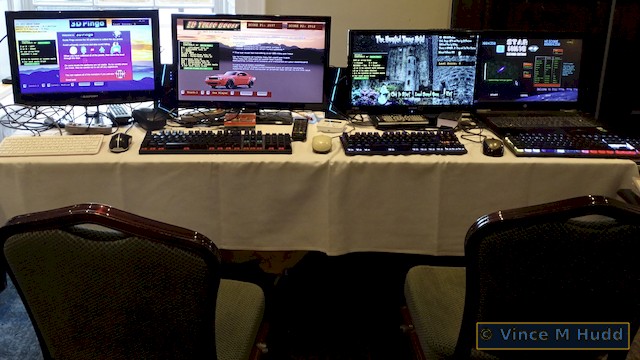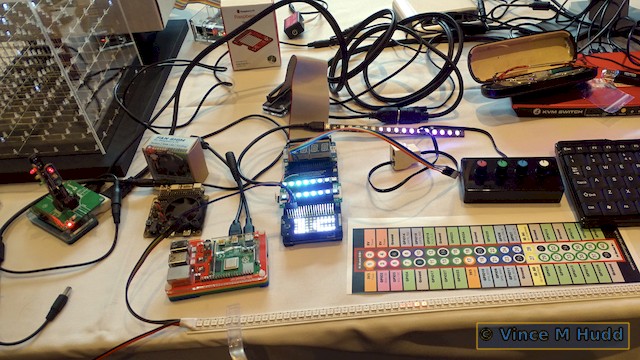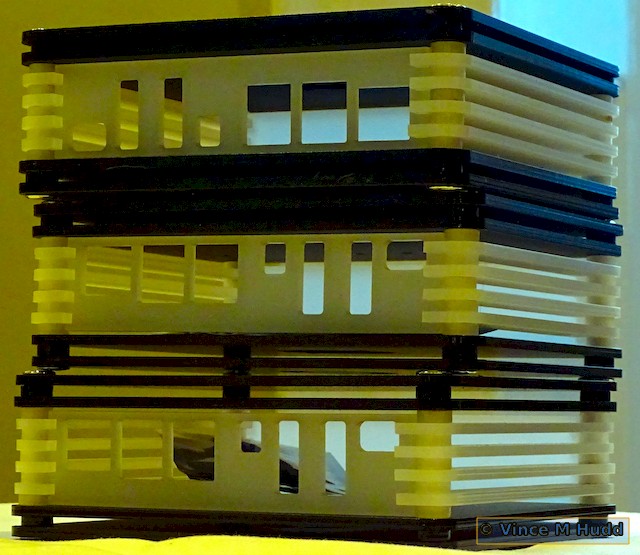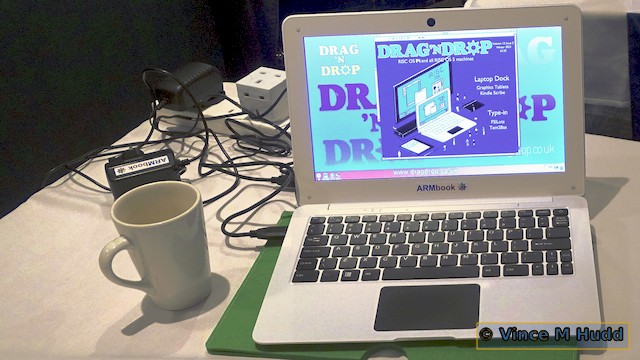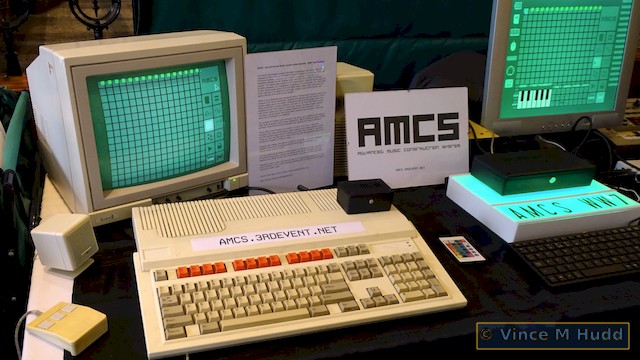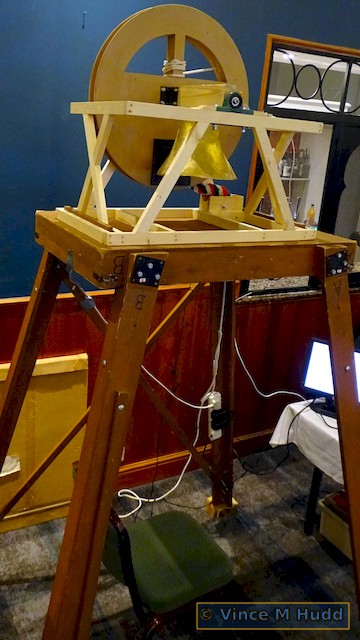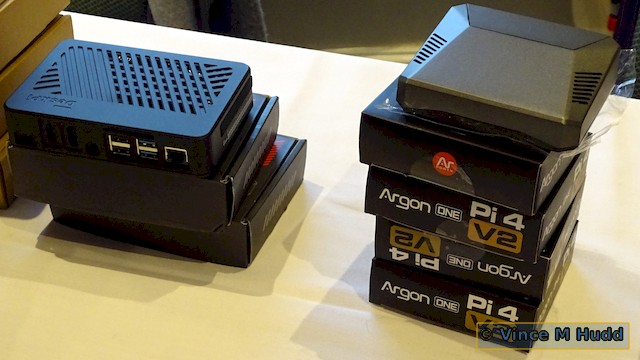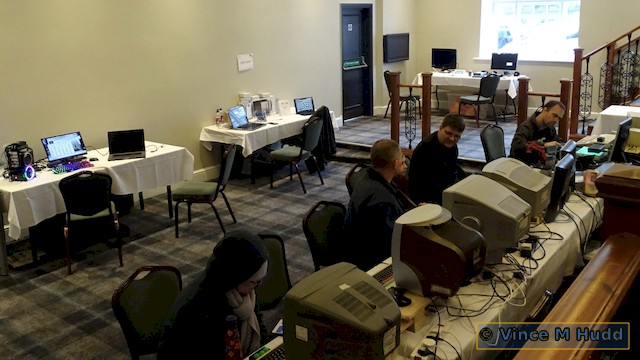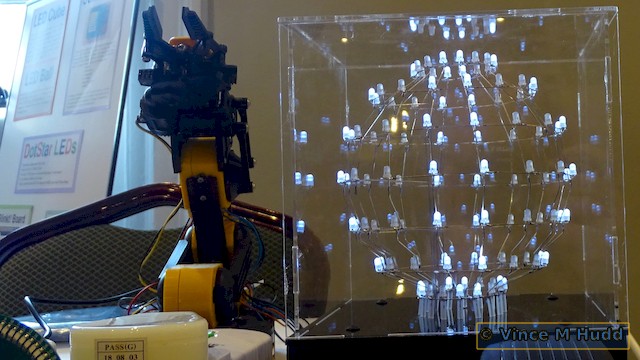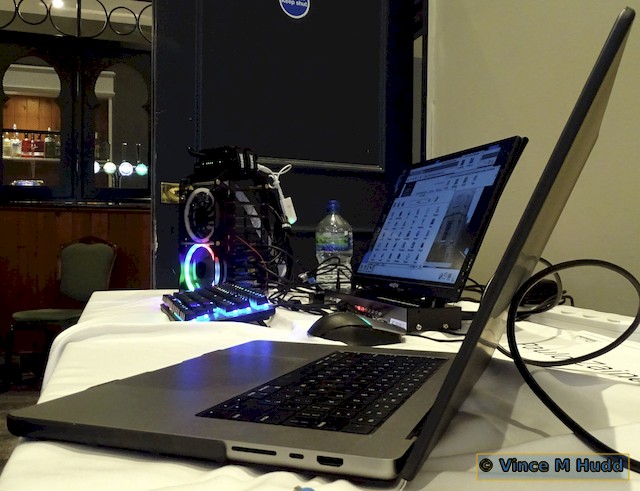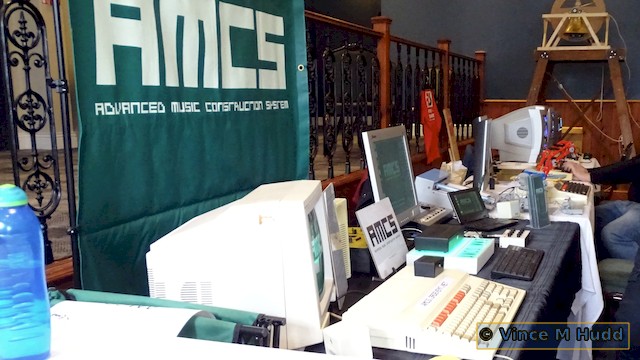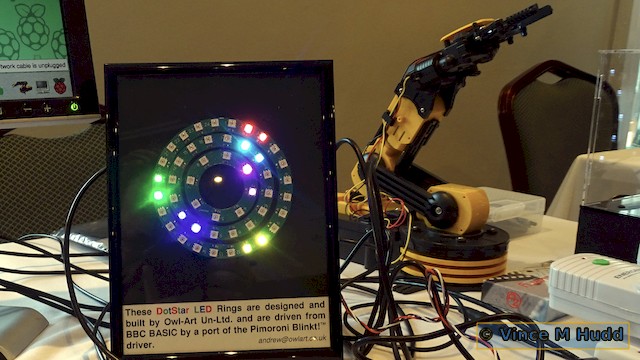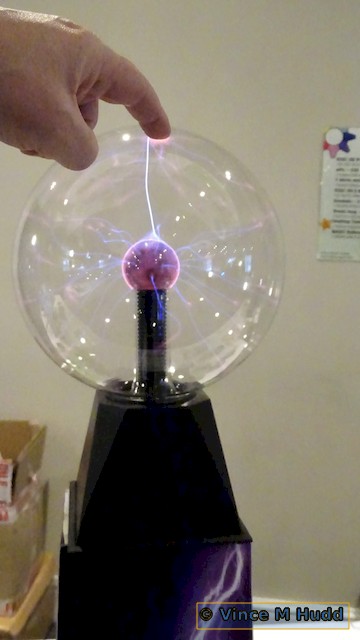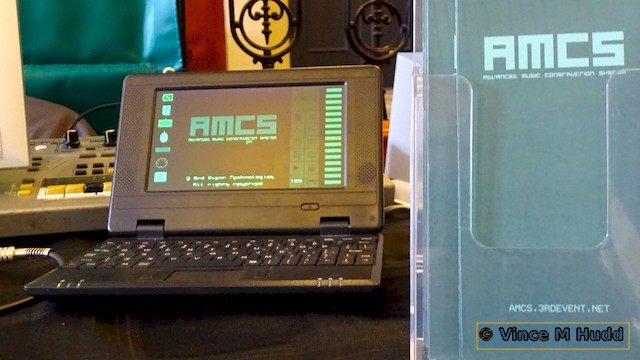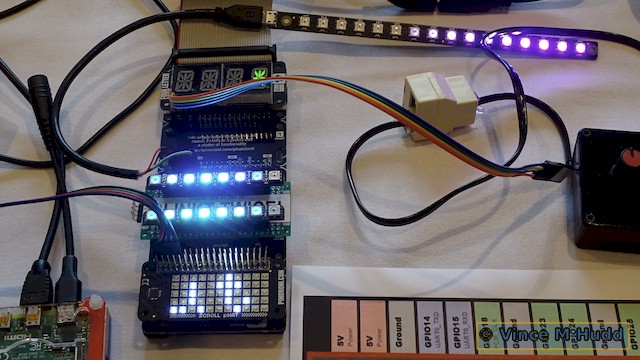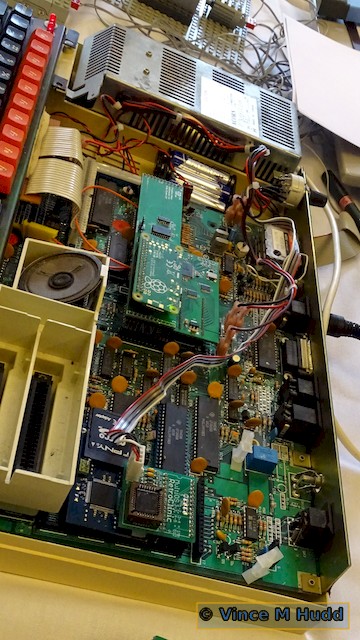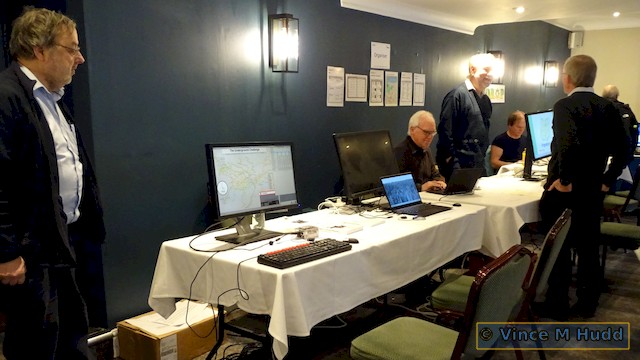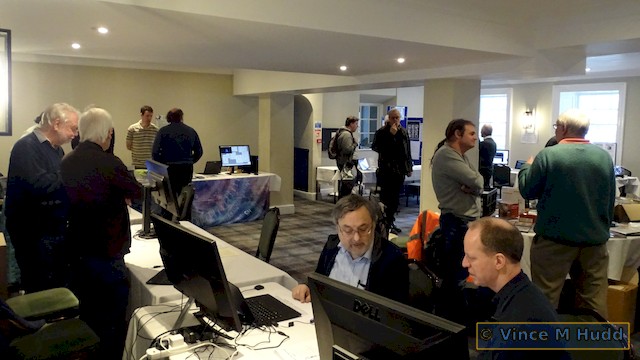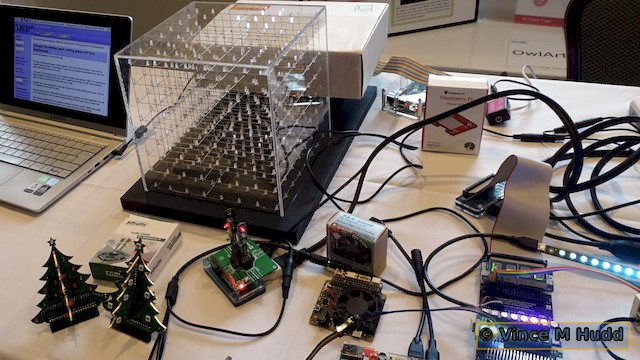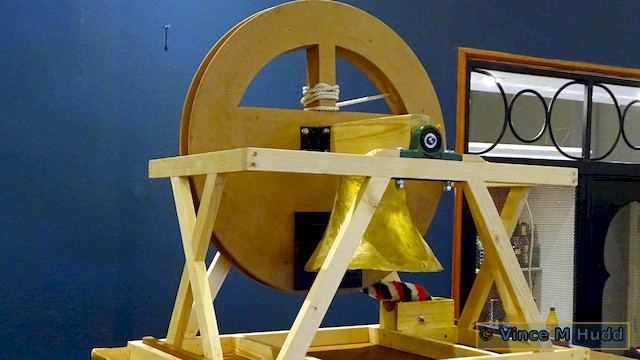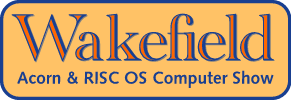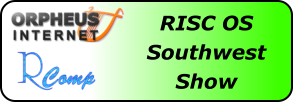25th February 2023 saw the RISC OS Southwest Show return to the Arnos Manor Hotel in Bristol. This was the first time the event has taken place since just before the Covid pandemic hit the UK, with the last one pretty much on the eve of the plague landing on our shores in early 2020.

Understandably, given the demographic of the RISC OS user-base – as also seen at last year’s Wakefield Show and the London Show the year before – attendance was notably lower than it has been previously, but in spite of that it was an upbeat show, with plenty for the visitor to see. It’s therefore time to put myself into a visitor’s shoes – no, not yours, I’m speaking metaphorically, but thanks anyway – and take a trip around the show to recount what was there.
As regular visitors to the show in its new/current venue will know, three rooms are used for the event. The smallest of these is the show theatre, where any talks are held, and then there are two rooms used to accommodate the exhibitors. The larger, main room, and a smaller one that connects to it (and sits between the main room and the theatre room, except when the chapel is used for the theatre instead, as in 2020, in which case it’s the bar -hic!- that sits between the two).
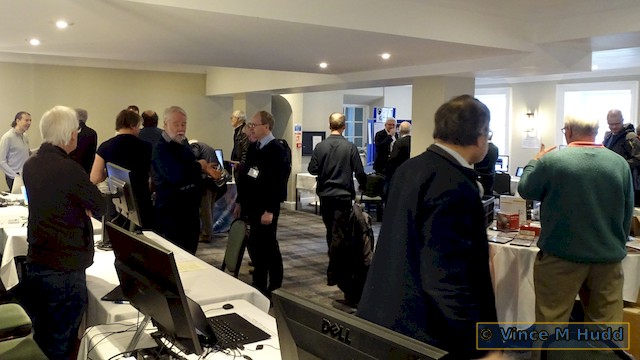
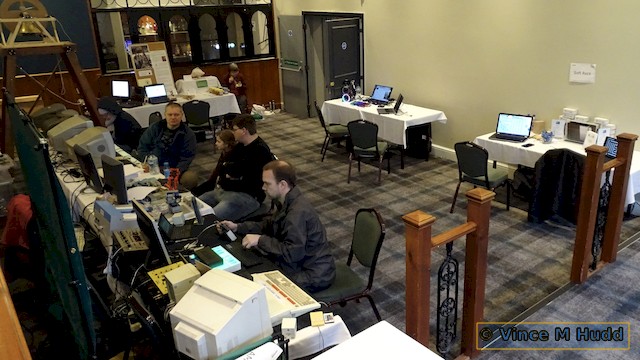
This report will take a straightforward walk around the show, following a clockwise direction for the first half of the main room, moving into the second room when the appropriate point is reached, then coming back into the main room until we reach the final stand. So, as you ventured in, you’ll have paid your entry fee at the first stand, belonging to:
RISC OS Developments
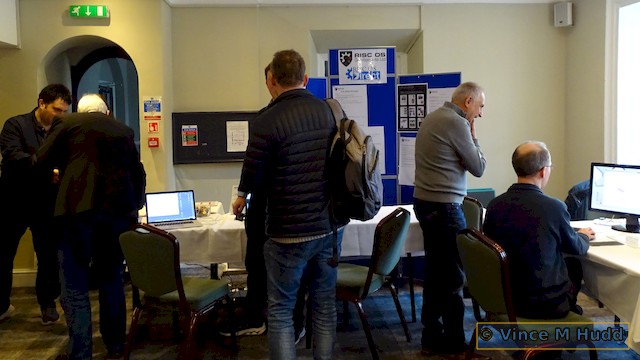
For anyone new to the world of RISC OS – and, yes, we do see new faces from time to time at shows, as well as new names on forums etc. – RISC OS Developments was formed in 2017 by Richard Brown and Andrew Rawnsley. Its goal: to prevent another war by creating a place where humans and aliens… I mean, um, to raise money to put towards the development of a web browser – but since those days, it became something greater: our last, best hope for victory oops, I mean, it has gone on to greater heights, taking on oversight of software such as Impression, and even ownership of the operating system itself.
Speaking of the web browser, although it remains in beta until it is considered stable enough for release (as opposed to complete – a web browser will clearly never be complete) show visitors were being given a voucher with an access code, allowing them to download and use it on their computers when they returned home from the show.
Another new development from the company is a Pinboard 2, a replacement for the default Pinboard that is supplied in RISC OS, and it was a demonstration of this that formed almost all of Richard’s talk (a couple of questions aside) in the show theatre:
The software provides quite a number of enhancements over the version that is supplied by default with the operating itself, and in terms of ‘modernising’ RISC OS and making it more comparable with the likes of Windows, they are much needed.
Orpheus Internet
As is often (always) the case at RISC OS shows, once you’d finished talking to Richard about RISC OS Developments, you could start talking to him about Orpheus Internet, the internet service provider he runs, and which was originally set up by the late Paul Vigay when ArgoNET decided to move away from providing internet connections.
It should be noted that Richard was being assisted on the stand by his daughter Serena (not that anyone is suggesting he needs that help due to his age or anything – at least not yet!), who had brought along a couple of props she’d made.

That’s definitely a raspberry (albeit a blue one) apparently, and not one of the pods from the Alien film – although you can surely forgive Yoda’s worried expression, because it sure looks like it could be a pod bursting open!
ROUGOL
A clutch of user groups took the next few tables, starting with the RISC OS User Group of London (ROUGOL), where Bryan Hogan was trying to coax people into attending the group’s meetings. Held on a monthly basis on the third Monday of each month, these days the meetings usually take a hybrid form, with some people attending in person and others attending online.
Just as with the show, the number of people joining ROUGOL meetings in person are much lower than they were before the pandemic, but for the group to continue to be able to hold them, those numbers need to improve. They meet in The Duke of Sussex pub, and low numbers could lead to the pub being unwilling to allow the (free) use of the room – so if you can head in for meetings, please consider doing so. Usefully, the pub is a very short walk away from Waterloo station, so it’s very easy to get to unless you’re a long way from the capital.
ROUGOL also organises the annual London Show which, unfortunately, couldn’t take place in 2022. A provisional date has been set for this year – 28th October – but the event is currently homeless with the usual venue unavailable, so that date may be subject to change depending on what can be found instead, if indeed anywhere can be found!
OwlArt / SROUG
The next user group represented was SROUG, the southernmost UK group – so far down the country it even has South in its name, being based in (and named for) Southampton. The group consists mainly of users in the Sussex and Hampshire areas, with some slightly further away, and when they meet they bring along any hardware or software they’re working on to show off to the others, or present any problems they’re having in the hope that, between them, they can come up with a solution.
The group has recently returned to meeting in person on the same pre-pandemic schedule and at the same venue – the 2nd Tuesday of each month, at Ichen College in Southampton.
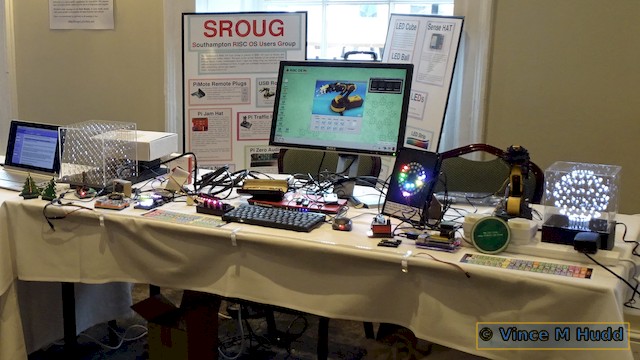
In his OwlArt guise, Andrew likes to tinker with programming and interfacing on and with the Raspberry Pi, which resulted in his stand being the flashiest one at the show. And by flashiest, I meant it had lots of flashing lights, which is a useful feature of this show – provided you were in the main room, his stand could be seen from all directions, so if you got confused about where you were it could serve as a shining beacon in space… all alone in the night er, I mean a way to regain your bearings.
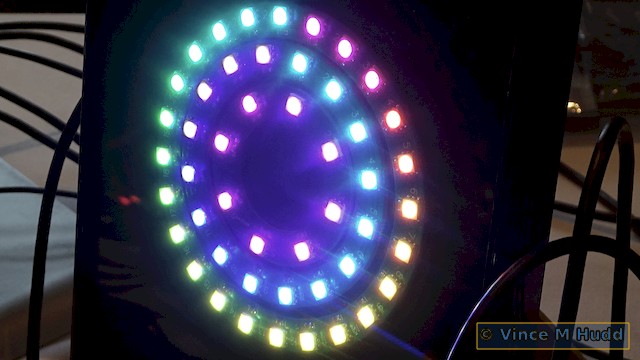
Amongst Andrew’s many gadgets this time were his Borg LED cube and sphere, one at each end of his table, a not so flashy robot arm, a set of DotStar LED rings, LED strips, and much more.
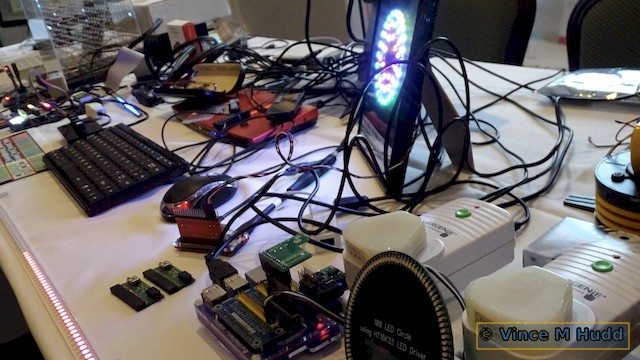
Tinkering on the Raspberry Pi is of course nothing new – the device (and a lot, if not all of the items Andrew has interfaced with one) was really designed for people to do just that. However, what’s important from our point of view is that Andrew’s control software for all of his projects runs on RISC OS.
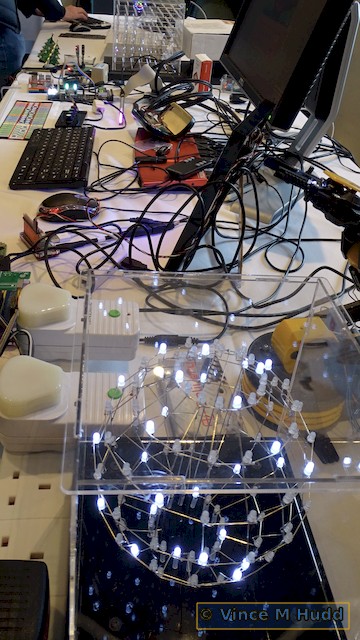
Midlands User Group
The third user group in this little line up was the Midlands User Group (MUG), ostensibly covering the Midlands area, but with members extending a little outside that range – certainly at least as far as Bristol!
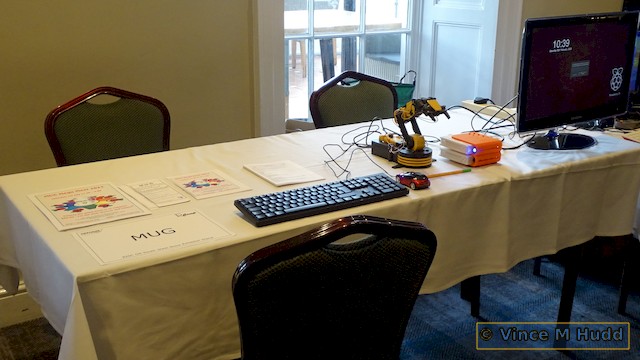
This group has a slightly different approach to hybrid meetings, in that the meetings aren’t set up with some people attending online and some in person – instead the hybrid approach is that some meetings are in person, and some are online. They normally take place on the first Saturday of each month, and when they are meeting up in person it’s in the Wychbold village hall (which, while this report was being written, has been renamed as Dodderhill Parish Community Hall).
Like ROUGOL, mentioned a few stands back, MUG also organises a show. In previous years (up to a point), this was the Midlands Midsummer Show, but declining visitor numbers saw the shutters pulled down on it, until last year when it was resurrected as an online event. This year, with a slight re-branding as the MUG Mega Meeting, the event took place on Saturday, 1st July. Videos from the event should be online before the end of this month – watch this space!
AMCOG
With a selection of ways to socialise with other RISC OS users covered on the last few stands, the next one provided a means to be completely antisocial; to shut yourself away with your computer, and only emerge for toilet and food breaks. And possibly to sleep, depending on whether you also took any coffee breaks. You might think I’m kidding, but anyone who has ever played computer games with any seriousness and determination to finish/win/complete the game will have behaved like that at some point in their lives, and probably more than once.
This was the AMCOG stand, where Tony Bartram was dealing in that narcotic of the twitchy fingers – his range of games for RISC OS.
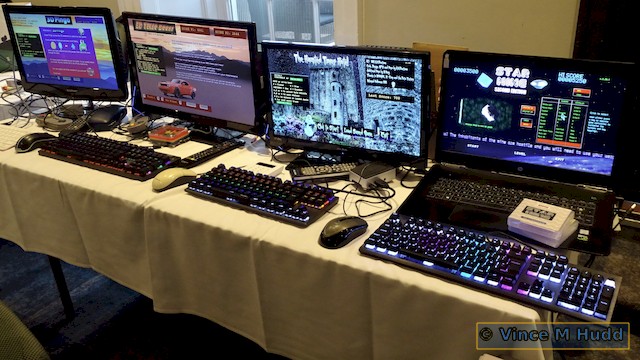
A programmer by day, albeit in a different field (and on a different platform), Tony somehow manages to be quite prolific when it comes to games on our operating system – and if you want to know how many he has released, the easiest way to approximate it is to count the number of shows at which he’s exhibited, then add a few.
The number will be an underestimate because there are some in addition to his commercial releases, but as a general rule, if there’s a show there’s probably a new game, and this event was no different, with the launch of his latest title, 3D Turbo Boost.
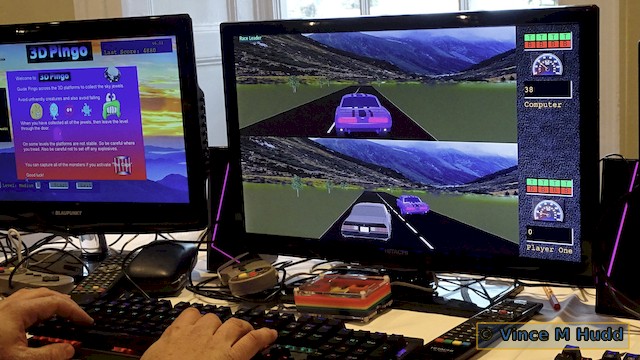
Putting yourself up against either another player or the computer, the game offers a split-screen view of the action on the road, where you’re racing to test cars equipped with new technology allowing them to be driven at ultra-high speeds and launch themselves into the air to jump over obstacles.
RISCOSBits
In the run up to the Southwest event, we saw a series of teases from RISCOSbits appear on Twitter, hinting at something significant being released for the show, and that something turned out to be RISC OS FAST.
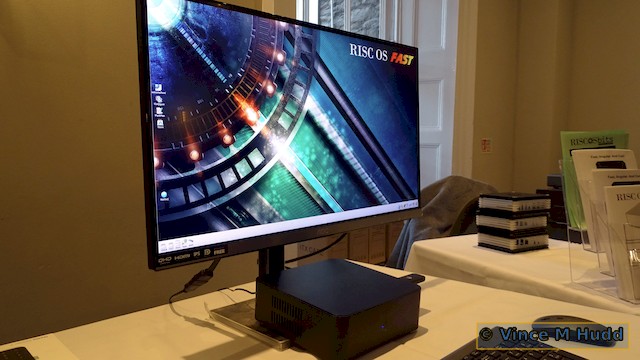
In the context of RISCOSbits’ new product, FAST stands for ‘Fast Access Storage Technology’ and is a version of the operating system with some sauce added to allow it to access the PCIe port on the Pi Compute Module 4 Lite and, with a little hardware thrown into the mix, gain access to up to four full speed SATA ports.
This means that FAST isn’t just a meaningless word in the product’s name – for any task that requires disc access, there are real speed gains to be had, and the more disc intensive that task, the greater those gains can be, with some being quite significant indeed. Compiling a RISC OS ROM image is the example given by Andy Marks, explaining that it is a much, much quicker job on a FAST system than any other RISC OS kit.
Although there was only very limited availability at the show, there are a number of hardware options to choose from, including not just complete RISC OS FAST computers but also the bare bones of the system – an SD card containing the necessary ROM image and the SATA hardware device to connect to your own Computer Module 4 Lite-based system, all of which is detailed on the dedicated RISC OS FAST website.
Although new for the Southwest Show, RISCOSbits’ also had products that were new for the London Show that didn’t happen, so this was the first time they’d appeared at one. An example was PHANTom, a Raspberry Pi HAT (Hardware Attached on Top) device that can be used to control the speed of a fan based on the CPU temperature.
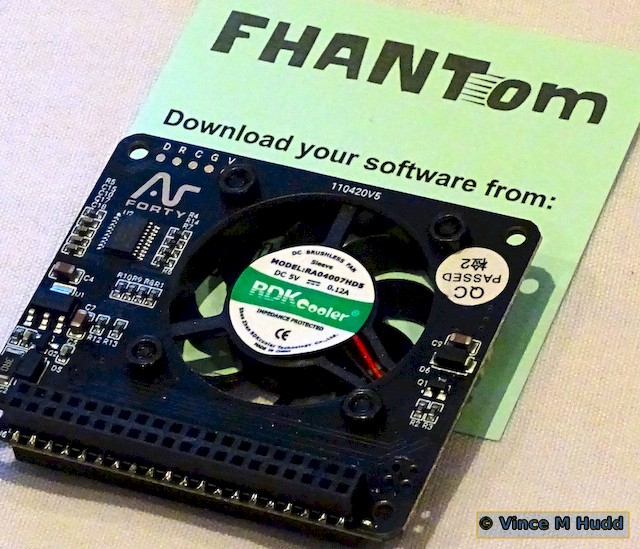
And another product launched for non-London and which therefore made its first show appearance in Bristol was EDOS/SD – a large SD card, suitable for the Raspberry Pi 4, containing both RISC OS and Linux, and a partition that can be accessed from both operating systems – a ‘plug-in and go’ solution to turning a Pi into a dual-boot machine. In addition, Andy was now selling EDOS/USB, a 128GB USB thumb drive with everything needed to upgrade an existing system accordingly.
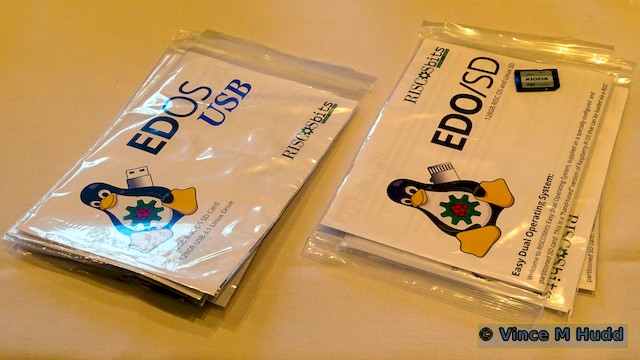
Steve Fryatt
And then we – sort of – come to another user group. Steve Fryatt was on the next stand, and as the only exhibitor at the Southwest Show that could arguably represent the Wakefield RISC OS Computer Club, I did wonder why he wasn’t punting memberships – and for that matter, although this didn’t occur to me at the time, the Wakefield Show, which took place only a couple of months later.
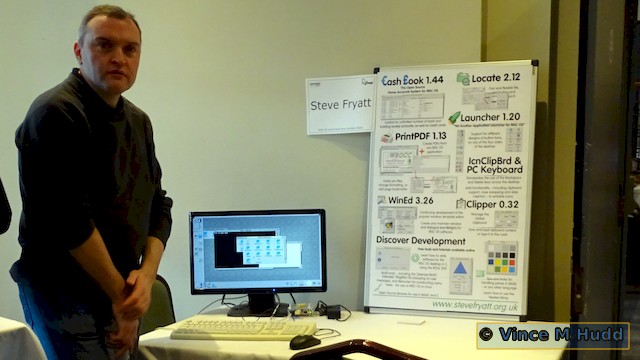
I did mention the lack of advertising on his stand for the group (though not the show for the reason above), and his explanation included time, or lack thereof, and getting ready to head down to Bristol for the show. We all have variations on that problem, I suppose, but I feel it was something of a missed opportunity. WROCC is, I believe, the largest – and definitely most formally run – RISC OS user group in the UK, and deserves a bit of promotion.
On the other hand, WROCC is the probably the largest RISC OS user group in the UK, so perhaps they don’t need it? *shrug*
Anyway, that aside, Steve was showing off his range of software as usual, which includes the grumpy personal accounts package CashBook, PrintPDF providing a tidy user experience for producing PDF files, and much more.
Paolo Fabio Zaino – RISC OS Community
Skipping through the doors into the smaller room, the next exhibitor was Paolo Zaino, the man behind the RISC OS Community – although he might argue that we are all a part of that, but he’s certainly responsible for setting up and overseeing the RISC OS Community on GitHub. A new face at RISC OS shows – though far from a new face on the RISC OS scene, Paolo started his RISC OS journey around the same time as most of us, back when the operating system was itself new.
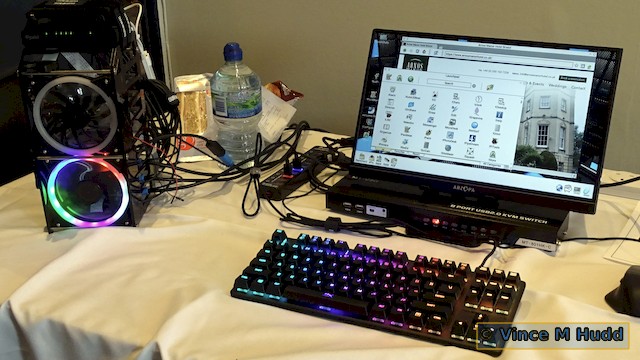
Paulo was demonstrating Launchpad, a piece of software which – as part of the desktop modernisation project – is intended to bring more modern features and ways of working to RISC OS. In this case the software is an alternative application launcher to the default one provided by the operating system, Apps.
Whereas Apps shows you the applications it contains (or which have been ‘added’ to it via the mechanism provided in the computer’s configuration) in a way that makes it look like a standard filer window, Launchpad goes a huge step further. The main pane still shows the grid array of application icons, but with additional panes to allow searching for specific applications or launching the online repository systems. Applications can be tagged so, for example, you can have the display limited to graphics applications, or internet applications, or whatever, and you can even have tabbed groups of icons.
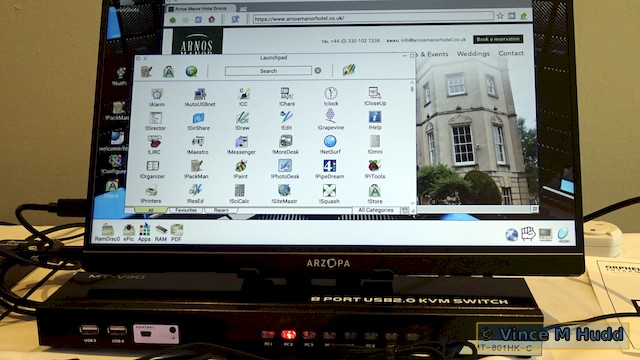
Paolo will also gladly tell you about the rack he has at home, with all manner of RISC OS machines set up on (in!) it, all accessible from the same desk at the flick of a switch. Travelling to Bristol by train meant bringing that along to show it off was out of the question, so he instead brought along a smaller equivalent.
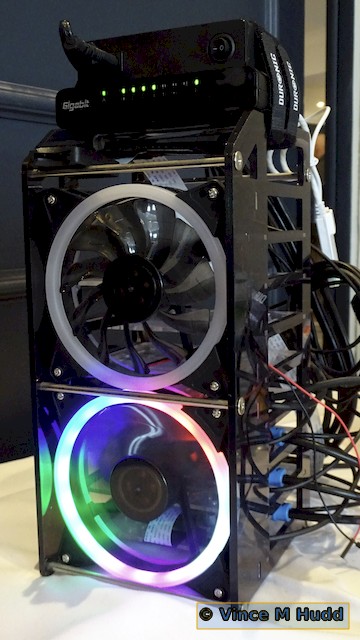
Housing a number of Raspberry Pis, he had loaned a mini-rack with built-in colourfully lit cooling fans, from his place of work. He’d set up in it a number of the single board computers, all running RISC OS, and any of which could be switched to via a KVM.
Soft Rock Software
More games were on display and available on the next stand, where I was representing Soft Rock Software. At least, I was doing so if and when I could actually be found at the stand because, as ever, I was often wandering the show, taking photographs, and talking to other exhibitors in order to have something to write about in this report!
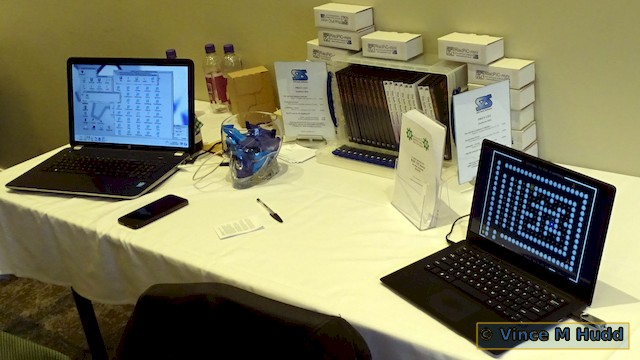
I really should be manning the stand in order to sell things to cover the cost of having the stand in the first place – but at least the Southwest Show is my local event, so the costs are generally kept to a minimum.
However, in the run up to this year’s show I purchased a Pinebook Pro (see later) from R-Comp and had installed the ‘2021 extended remix’ of Escape from Exeria on it – which was one of the things available to buy if I could be found.
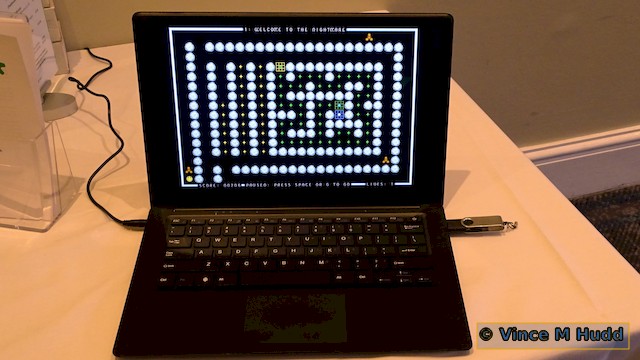
The ’21 version of the maze game runs at full HD (1920×1080 pixels, in 16 million colours) and features new sound effects. It includes the original forty levels, which play just as they did in the mid-1990s rewrite (in fact, better than they did, because a longstanding bug has been fixed) – but there are also forty new levels, on which there is a new challenge for the player.
The other laptop on the stand was running a work-in-progress follow-up to Drop Rock.
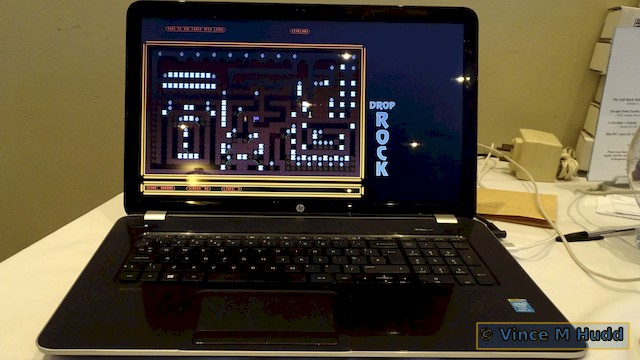
Based on the code from the mid-1990s rewrite of the original game, when finished this will present the player with a similar goal as that version, but with new challenges, and new larger level designs. Like Escape from Exeria, one of the changes is that it will run in 1920×1080, with 16 million colours, although the WIP is running at 1920×1080 in 256 colours and using the old tiles, so it doesn’t fill the screen.
Dynabyte
The end of the lower level of the second room is where Dynabyte Software could be found.
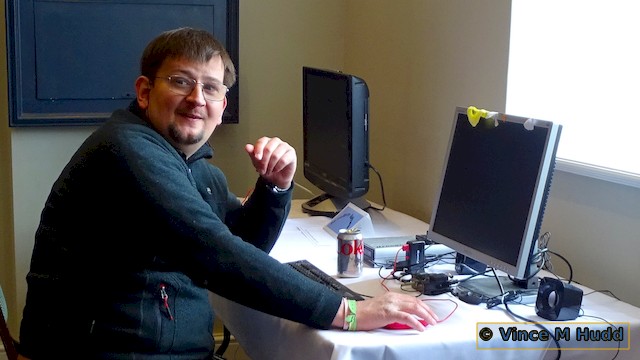
Gareth Lock has a range of software available to download, including multiple choice quiz game Quizzics – which for the Southwest Show saw an updated set of questions. The software also allows users to add their own questions, and to preserve those when installing updated sets from source, there is a new (separately downloadable) updater.
3rd Event – AMCS
After hitting the end of the room and Gareth Lock (er, what? shut up, you know what I mean!) it’s time to turn around and head back around the other side, to visit the next exhibitor – 3rd Event with the Advanced Music Construction System (AMCS).
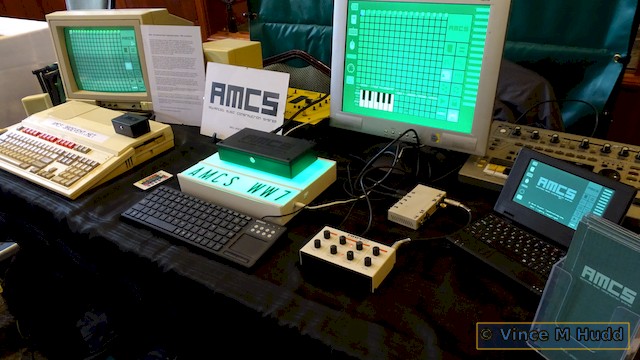
AMCS is a music sequencing system that started out as something that ran on RISC OS, and evolved into something that ran instead of it, replacing the operating system completely. The original platform of choice for AMCS was an Acorn A3000 – but it has since been ported to run on other ARM-based devices, some of which were on display at the show, including the AMCS WW7 workstation, which runs the software on the ARM11-based VIA Technologies APC8750 board.
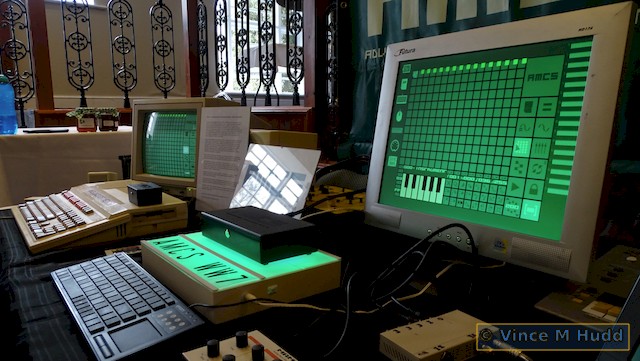
Rob Coleman
The next exhibitor was Rob Coleman, with his enhanced 8-bit system – a BBC Master kitted out with a Raspberry Pi Zero.
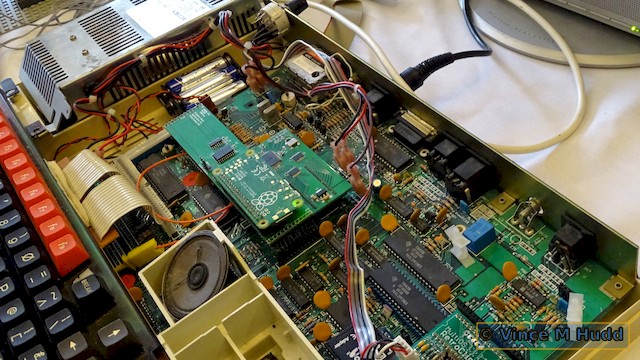
With the hardware suitably enhanced, the computer becomes a much more powerful, capable machine than it ever was, and the BBC Micro range was already quite something at the time. One of the fun things Rob was running at the show was a Sinclair ZX Spectrum emulator, which isn’t something you’d ordinarily expect a 6502-based computer to be able to sensibly pull off, but it was actually running very smoothly. A very impressive piece of work.
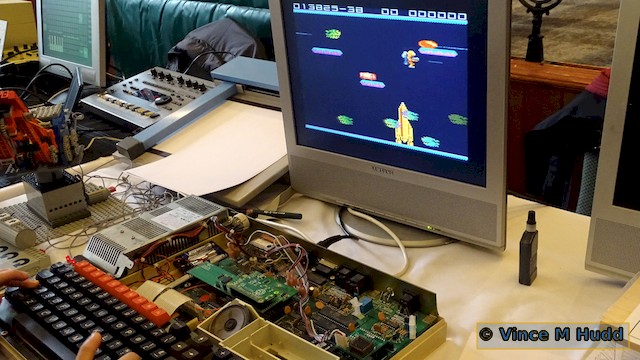
Rob also acts at the Southwest Show as the face of the Acorn and BBC User Group, aka ABUG, a group that meets up at different times, and different locations around the country to discuss (and show off) the projects they are working on. Organising these events is generally done via the Stardot forums.
Retro Software
Following Rob, there was a selection of games running on a few BBC computers on the Retro Software stand. Richard Broadhurst – aka Tricky on the Stardot forums – appears to have been a very last minute addition to the list of exhibitors, having only spotted a comment about the show and agreed to come along less than a week before.
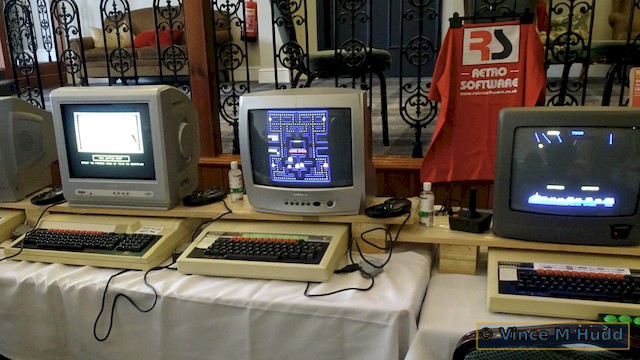
I didn’t speak to Richard on the day, but it appears that while he’s exhibited at other RISC OS events, this was his first time at the Southwest Show – so I hope he found it worthwhile enough to consider attending again.
John Norris – bell ringing
The penultimate spot in the smaller room is usually home to John Norris, who always brings along his creative campanology kit – and quite a piece of kit it is, because it consists not only of a bit of software running on a computer, but also a peripheral device of some note.
I’m referring, of course, to his papier-mâché bell, sat atop a large wooden frame!
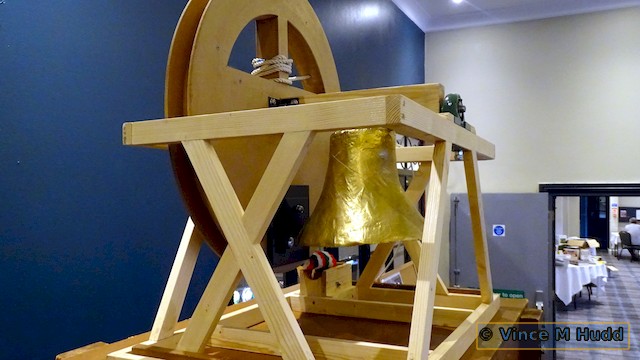
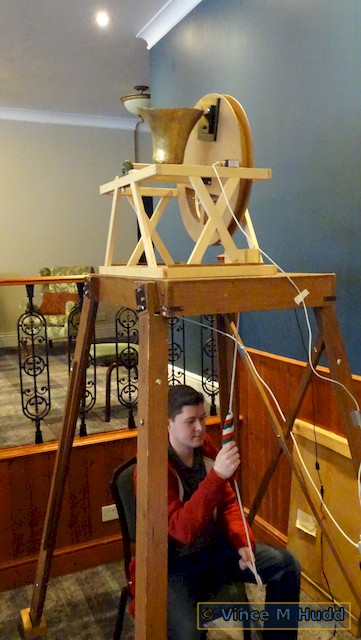
The idea of the set up is to provide an individual with a way to get in some bell ringing practice, by allowing them to ring a bell that doesn’t make a sound. Instead, the computer plays a particular sequence with one bell missed out, and the ringer’s task is to ‘play’ the missing bell. The action of ‘ringing’ the silent bell triggers motion sensors that relay the information to the computer, which then fills in the sound of the bell at the point it is rung – which, depending on the skill of the ringer may or may not be at the right time in the sequence being played. (Apparently, the chap pictured is a very skilled ringer – so those rings will have been playing at the right time in this case!)
A show regular, John has been exhibiting at the Southwest exhibition for nigh on twenty years, and is planning for this year to be his last. With that in mind, the show organisers arranged a small tribute to him and his wife Mary. I was talking with John about his change-ringing software – and just happened to be filming – when that tribute took place:
(Apologies for the camera shake – particularly during the applause; a crowd had gathered, so there was a bit of jostling as I filmed!)
In an email shortly after the show, John provided me with some dates that are worth noting. The bell and tower set up shown above first appeared at the Southwest Show in 2006 – so it’s now been appearing for eighteen years (ignoring any gaps with no show), and is therefore entitled to a wee dram to celebrate.
Before the larger structure, a smaller version also appeared at a couple of shows – the Southeast event in 2004, and the Southwest one in 2005. John included a photograph of the smaller version being rung by RISC OS enthusiast and bell ringer, Alan Griffin – and so I have taken the liberty (and I’m sure I should be making a joke about a liberty bell at this point) to include it here:
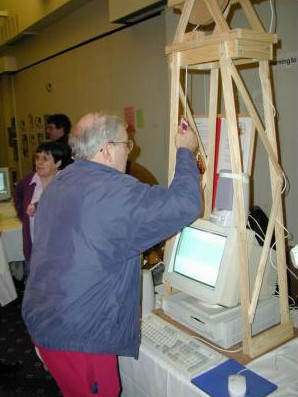
Tasty Treats
One of the benefits of John being at the Southwest Show is that Mary, his wife, will also be there, and Mary brings along a selection of Tasty Treats – her range of home-made jams, marmalade, and chutneys.
The jams etc – as noted in the video above – haven’t been appearing (and therefore disappearing) at the show for as long as the bell, but they will definitely be missed!
Charity
Heading back into the main room, the central area was given over to the Charity stand, where there was a wide selection of books, magazines, software, some hardware, and lots of other random items to be had.
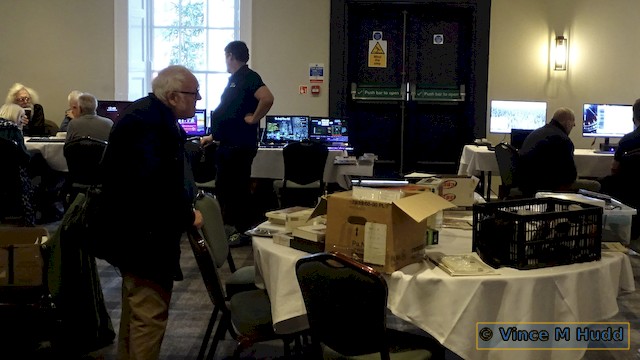
I’ve been an Ovation Pro user for many years, having first bought it at an early Southwest Show, funnily enough – but I’m not sure if I ever had any proper, printed manuals for it. I don’t remember having any, but it’s also possible I’ve misplaced them (and forgotten they existed). So I was quite pleased to find an Ovation Pro Reference Guide on the stand this year.
The sale of that manual to me was just one small sale on the day that contributed to an overall take of £165.00 – which Moss, who was manning the stand along with Ian Karley, told me went to Secret World Wildlife Rescue, near Burnham-on-Sea.
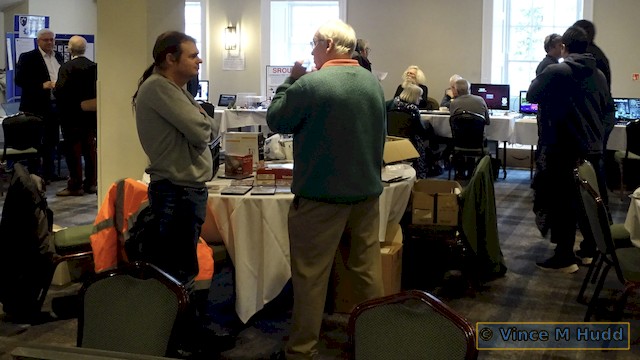
R-Comp
Returning to the main exhibitors, next to the door was R-Comp who amongst other things had brought along the PineBook Pro. Previously shown off at and talked about in user group meetings, development of the RISC OS port for the machine had been underway in the months leading up to the show, and it was officially on sale on the day.
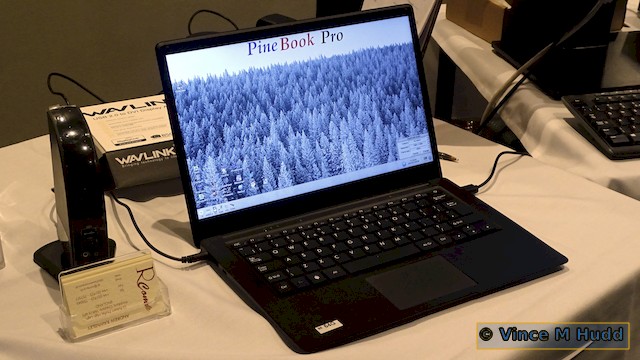
R-Comp’s Andrew Rawnsley delivered one of the day’s theatre talks, in which the PineBook Pro – and some connectivity accessories for it – was one of the main topics:
One of those connectivity options include a USB-based option for connecting the machine to an external display using either HDMI, DVI, or VGA. The devise is small enough to be as portable as the machine itself and should cover most requirements for both monitors and – usefully for demonstrations and talks – projectors. The other was a powered dock, ideal for keeping on the desk at home or the office, offering not just a connection to an external screen, but also an ethernet socket for connecting to a wired network, as well as additional USB devices.
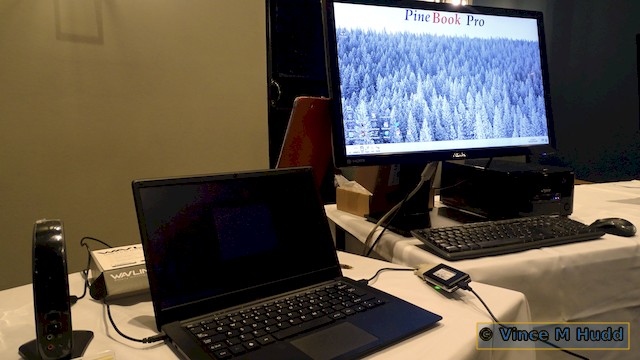
Andrew also covered PhotoDesk in his talk. Purchased by Netherlands-based XAT in 2020, further development of the software is now looked after on their behalf by R-Comp, who also handles sales in the UK while XAT deals with that side of thing in Europe. The latest version of the software builds on the work previously done on it when it was in the hands of CJE Micro’s, and now includes a brand new (PDF) manual that is written more as a tutorial than a reference manual, showing how to use many of its features step by step, with example images.
The third main subject Andrew talked about was the Pi 4-based sixteen hundred 4té2 computer.
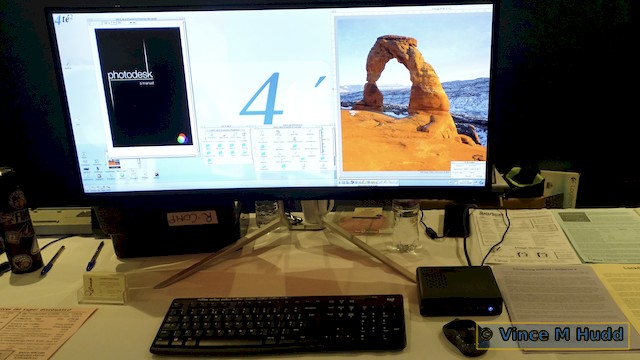
A small footprint computer, it can be supplied not just with RISC OS, but also as a dual-boot machine with a version of Linux installed, and suitably configured storage to allow files to be easily shared between the two.
Chris Hall
The next stand was occupied by one of the Southwest Show locals, Chris Hall, who was showing off a variety of his projects, which include software, hardware, and documentation.
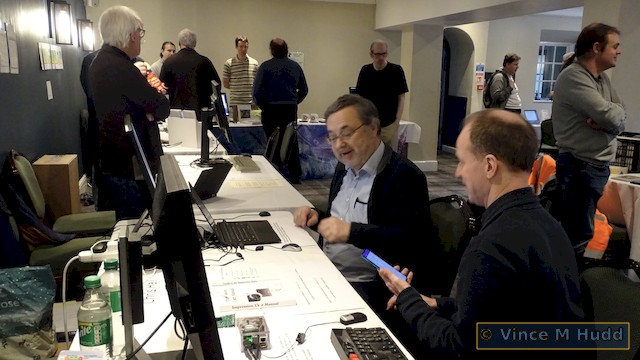
One of Chris’ projects that covers both hardware and software, demonstrated now at many RISC OS events, is the SatNav application and the GPS unit it reads from. These units were previously GPS modules available for the Raspberry Pi, connected via the GPIO pins, all housed in small, home made cases, with battery packs and so on to make them portable.
At this event, however, he had the software running on a PineBook Pro from R-Comp, with the satelite signal coming from a USB-connected GPS device. Chris gave one of the day’s theatre talks, at which he demonstrated this, with timing almost as perfect (but more coincidental than planned) as James Burke talking about how rockets work:
Chris also briefly mentioned his updated manual for Impression Publisher, which could be purchased from his stand and comes with a link to download a copy of the software. He noted that there’s now a second manual that covers other software in the Impression family, before moving on to some of his other software, such as his CountDown application. Like the numbers round in the television show, this allows six tiles to be picked, which have either values from one to ten on them, or the ‘large’ numbers 25, 50, 75, and 100, and presents a random number between 100 and 999, with the goal being to work out how to reach that number mathematically using the values on the tiles.
Unlike the TV show, however, the software also works out – in the blink of an eye – all of the possible solutions from those selected tiles, and therefore how many ways there are to make any given result, and thus is able to suggest how easy (more solutions), difficult (fewer solutions), or even impossible (no solutions at all) the target will be to achieve.
Organizer
Moving along, the – no THE – personal information manager for RISC OS, Organizer, was being demonstrated and sold by Nigel Willmott and Martin Avison.
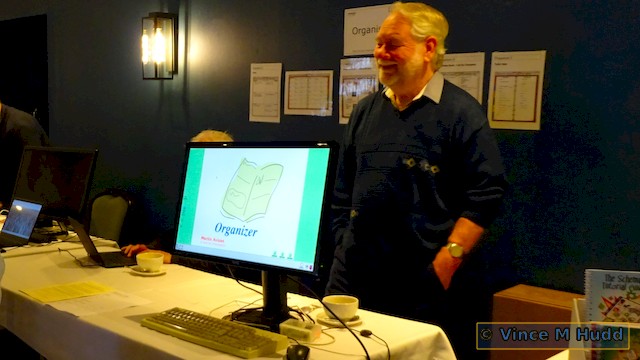
The software can be purchased as a download, or in its ‘on a stick’ form, which is the application itself supplied on a USB memory stick along with a copy of RPCEmu. This makes it very portable because you can simply drop it in your pocket and use it with any typical PC, wherever you are – as long as the PC’s owner is willing to let you plug it in and use it.
There was a minor update to the program in time for the show, with the letter suffixed to the main 2.29 version number changing from a ‘b’ to a ‘c’. This update brought changes to the Holidays file to account for the 2023 Coronation, and fixes to a number of small problems, such as addressing an issue whereby an Organizer Alarm Notification having the input focus can prevent the F12 key being used.
Drag ‘n Drop
Only one of the platform’s main magazines was represented at the show, and that was on-off-on-off-under-new-management PDF magazine Drag ‘n Drop, with Chris Dewhurst ready to sell you a USB thumb drive containing every issue of the magazine so far, including the latest.
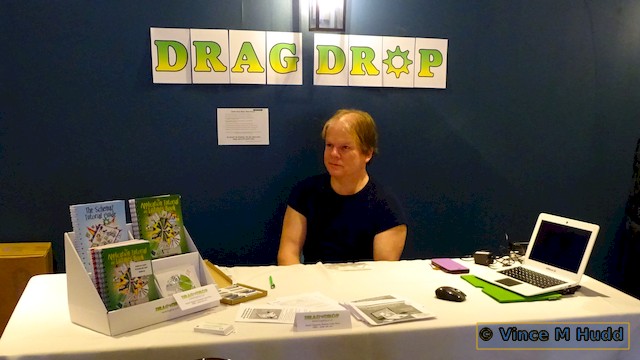
The magazine isn’t the only publication Chris offers, and he also had a selection of these available. These included CDs containing older tomes as PDFs, such as his collection of eighty BBC Micro books, and various actual books that he’s published under the Drag ‘n Drop brand, such as a tutorial for the Schema spreadsheet, and another for Draw.
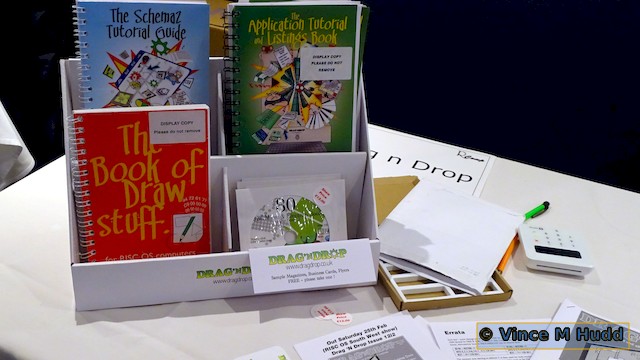
Chris also gave one of the day’s talks, but because he was asked to do so (or as he put it, pressganged into it) at the last minute, he simply made it a quick run through of the latest issue of the magazine:
RISC OS Open Ltd
The final stand belonged to RISC OS Open Ltd (ROOL), who maintain the operating system on behalf of its owners, feeding changes into it and releasing updates as and when they are deemed ready, along with the main development environment, user guides, and so on.
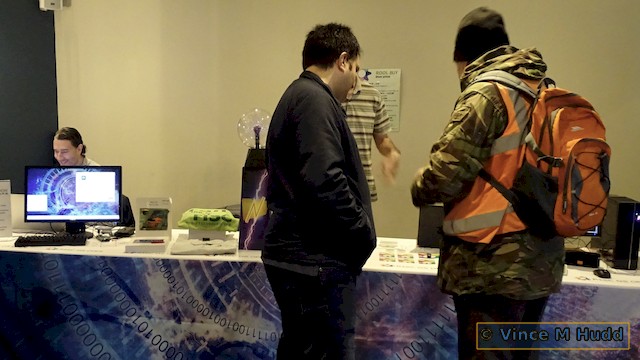
Originally charged with managing the RISC OS in its ‘shared source’ form, ROOL still perform that same task now that the operating system is fully open source. That’s only part of the picture, though, because the sources wouldn’t be much use to most of the RISC OS community if they weren’t available in a compiled form with the supporting applications and other software that forms the main distribution. And by that I mean beyond the core elements that originally came in-house from Acorn – some third party software is also included, and there was a particularly notable new addition to the ‘disc image’ announced in the run up to the show, which ROOL celebrated on the day with an extra toy on their stand:
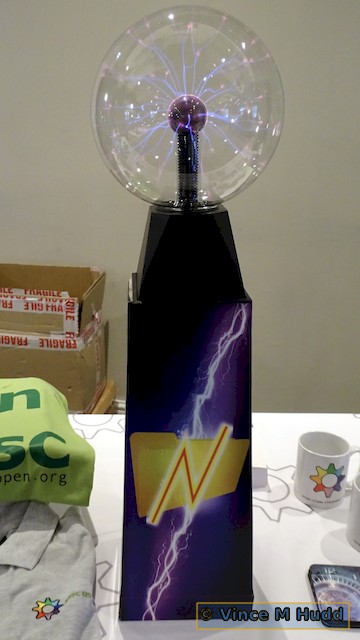
The new addition was a full read/write version of SparkFS, originally a commercial product from David Pilling. The free read only version was previously included in the RISC OS disc image from ROOL, which meant users could easily open zip files and other archives – a common way to make software available online – but now they are able to create those files right from the get go.
As well as including SparkFS in the disc image, with David’s support ROOL has been able to include SparkFS’s source code in its GitLab repository, making it another piece of software that they manage, and which other developers can work on and further develop.
Steve Revill took to the show theatre to talk about what is currently happening at the company – where things are with the bounties, and so on.
The talk also covered the state of play with development towards the next ‘stable’ release of RISC OS and what sort of things users can expect from it – such as a version of Paint with some notable improvements, including a long-standing bug finally vanquished, not to mention new and quite welcome features in other parts of the OS as well.
And along with the various items of software sold by ROOL, which includes the Desktop Development Environment, SD cards containing distributions of the operating system, and so on, the company also has a range of merchandise available to buy at shows – with something a little cleverer available for this one.
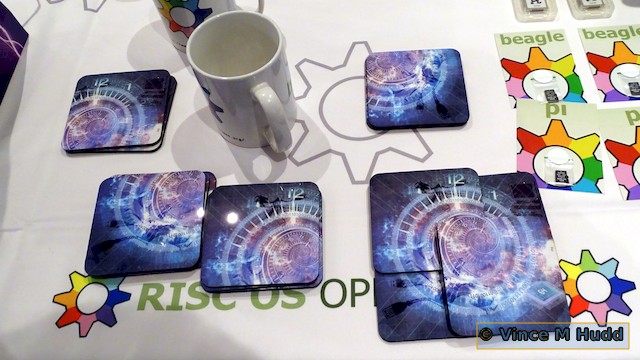
In closing
So that was the 2023 Southwest Show – the first one in three years. While it wasn’t the first post-pandemic (physical) RISC OS show in the UK, like the 2021 London and 2022 Wakefield shows, it still has to find its feet. All three have seen a smaller footfall in this rebooted era – but all three were very enjoyable in spite of that.
Indeed, the organisers – Richard Brown and Andrew Rawnsley – have confirmed that they will press on with another show next year; with the ever increasing cost of running the event, had the show been unsuccessful it’s unlikely that would have happened.
The next few events in the RISC OS calendar have now already taken place – Wakefield in April, the Big Ben Club’s RISC OS eXperience in May, and the MUG Mega Meeting in July – so the next one will either be the London Show, if it takes place, or the Southwest Show again in 2024.
Whichever of those two it is, I hope to see you there, and in the meantime here are a few more photographs from Southwest 2023:
